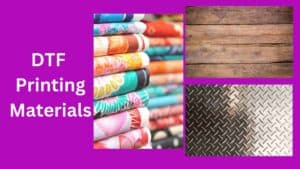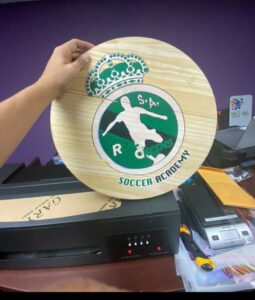For printing on t-shirts, hoodies, and other garments, garment industry uses DTF printing on a large scale. Several firms like DTF printing technology because it makes it simple to print intricate shapes and patterns. It’s crucial to know what materials can DTF print on to get the required results. In this blog post, we’ll talk about the different kinds of materials that you can print on with this evolving technology, as well as its limitations and other options.

What Materials are Best for DTF Printing?
Fabrics
What materials can DTF printers use? It can perform on many fabrics. They consist of:
- Cotton: Cotton is a popular DTF printing cloth. This material offers a flat surface for printing and is breathable and easy to wear.
- DTF printing on polyester: Because to its durability and wrinkle resistance, polyester is a preferred fabric for DTF printing. It does not quickly fade and has good color retention.
- Blended fabrics, such as cotton-polyester blends, can also be treated with technology. These materials combine the strength of polyester with the comfort of cotton to provide the best of both worlds.
- Silk: Using DTF technology, you can print on silk, a pricey fabric. It offers a shiny, smooth surface for printing, and because it’s lightweight, it’s ideal for making delicate designs.
- Denim: Denim is a durable fabric that industry uses to make jeans. DTF technology can print custom designs on it.

How to print on fabric to get high-quality results:
- Choose superior cloth for printing.
- For bright colors and a longer print lifespan, use premium DTF ink.
- Before printing, clean the fabric well.
- The printer pressure, temperature, and time should match the fabric.
- To set the ink and make sure the print lasts longer, use a heat press or dryer.
Non-fabric materials
DTF printing materials that are non-fabric:
- Ceramic: We can print patterns using DTF technology on ceramic tiles, mugs, and plates. The prints hold up well and are scratch- and fading-resistant.
- Metal: DTF can print on aluminum and stainless steel. This is very helpful when making customized keychains, bottle openers, and phone cases.
- Glass: You can print custom designs on glass surfaces including mirrors, windows, and glassware.
- Wood: DTF printing is also possible on wood surfaces like plywood and MDF. This is helpful for designing individualized furniture, wall art, and signs.

Observe these pointers to get superior prints on non-fabric materials:
- Before printing, make sure the surface is clear of all debris, grease, and grime.
- Modify the printer’s pressure, temperature, and timing to fit the material. Apply a priming or base coat before printing to improve adherence and extend print life.
- For bright colors and a longer print lifespan, use premium DTF ink.
- DTF printing is not possible on all non-fabric materials. Heat-sensitive or irregular materials may not be suitable for DTF printing.
- UV printing or screen printing may work better on those materials.
Limitations of DTF printing
While DTF printing technology has many benefits, there are some drawbacks to be aware of. Heat-sensitive or irregularly textured materials may not be suitable for DTF printing. It may not work for materials with a lot of detail or a large surface area.
This technology also has the drawback of requiring expensive, specialized supplies and equipment. DTF printers and inks are more expensive and require more maintenance than regular printing equipment and supplies.
Eventually, in order to produce high-quality prints with DTF printing, you need a certain level of knowledge and proficiency. To achieve the required results, equipment setup and calibration, as well as understanding of settings and methodologies, are essential. This means that when choosing a DTF printing supplier, training and experience are crucial things to take into account.
Even though it has these problems, DTF printing technology is still a popular choice for many businesses because it is flexible, durable, and can make high-quality prints. Businesses can decide if DTF printing is good for them by considering its drawbacks.
Can DTF be used on hard surfaces?
DTF printing works on hard surfaces including ceramics, metals, glass, and wood. It is a useful technique for producing individualized products like phone cases, keychains, mugs, plates, and more on hard surfaces.

However, Not all hard surfaces are suited for DTF printing. The surface has to be strong enough to resist the pressure and heat involved in the transfer process.
Certain hard surfaces may need extra priming to ensure print adherence and endurance. A competent DTF printing supplier can confirm if the hard surface is ready for DTF printing. He will also let you know how to utilize the optimum processes and materials to get the desired outcome.
Is DTF only for fabric?
No, DTF printing technology is not only for fabric. This printing technique can print on ceramics, metals, glass, and wood as well as fabric.
For DTF printing, we use a special printer to print the design onto a transfer film. Then, it is then heated and pressed onto the surface where it is to be placed.
We can use this transfer procedure on any material that can resist heat and pressure. Because to its adaptability, DTF printing technology is a preferred option for producing personalized goods including phone covers, keychains, mugs, plates, and more.
Conclusion
DTF printing, in summary, is a flexible technique that we can utilize to transfer high-quality prints onto a range of materials and hard surfaces. It works well on cotton and polyester textiles but also works on ceramic, metal, glass, and wood.
To get the finest results from any material, it’s critical to choose the appropriate transfer film, ink, and application method. Despite its restrictions, DTF printing is a cost-effective and fast method to print high-quality customized clothes, home décor, promotional products, and more.
FAQs
DTF printing may be done on cotton, polyester, and mix shirts. Yet, the garment must survive the heat and pressure of the transfer process. Clean, wrinkle-free shirts are best for transfers.
Yes of course, you can decorate mugs with DTF printing technology. It’s crucial to choose a mug that can handle the heat and pressure of the transfer procedure. Also, the mug’s surface should be clean and devoid of dirt or defects that might influence the transfer.
You shouldn’t do DTF printing on iron. A heat press with the right heat and pressure is needed for the transfer. Ironing DTF may harm the transfer film or cause uneven transfer.
Yes, 100% cotton shirts are suitable for DTF printing. DTF printing uses cotton because of its smooth surface and ink absorption.
DTF printing doesn’t work on all plastics. The plastic must tolerate heat and pressure during the transfer procedure. To ensure proper adherence of the transfer film, the plastic surface also has to be smooth and even.
DTF transfers often work well on cotton, polyester, or blend-made shirts. Polyester provides durability and color retention whereas cotton is famous for its smooth surface. While choosing the ideal shirt for DTF transfers, evaluate the application and intended result.
On spandex, DTF printing is possible, but it’s vital to take the fabric’s elasticity and stretch into consideration. The transfer film and ink should not split or peel when stretched by spandex.
Yes, you can print on Acrylic using DTF, but it’s crucial to make sure the surface is clear and free of any impurities that can interfere with the transfer.
Yes, 100% polyester fabric is suitable for DTF printing. Polyester is really a common material for DTF printing because of its sturdiness, colorfastness, and capacity for holding fine details.
We do not advise to utilize DTF printing method on paper. It is mainly ideal for printing on fabric and other sturdy materials including ceramic, metal, glass, and wood. Heat and pressure are used during the transfer process, which may burn and destroy paper. DTF printing ink is designed to stick to hard surfaces, not paper fibers, resulting in poor picture quality and durability.
DTF printing works on cotton, polyester, mixes, nylon, and silk. Unfortunately, not all textiles are appropriate for DTF printing, and some may need additional treatment or preparation before printing. It’s crucial to choose a fabric that won’t shrink, melt, or get stained when you expose them to the heat and pressure during the transfer process.

Ashley Wang is a skilled sales manager with knowledge in DTF printing. She presently works for ShenLan Digital, a reputable DTF printer maker. Ashley is the best person to offer advice on selecting the most suitable DTF printer because she has tested a lot of them. She launched DTFPrinterSchool to educate individuals and organizations about DTF printing technology, providing her expertise and observations on the most recent advancements in the sector. Ashley is an invaluable resource for businesses and individuals wishing to invest in DTF printing technology because of her expertise and experience in the industry.
